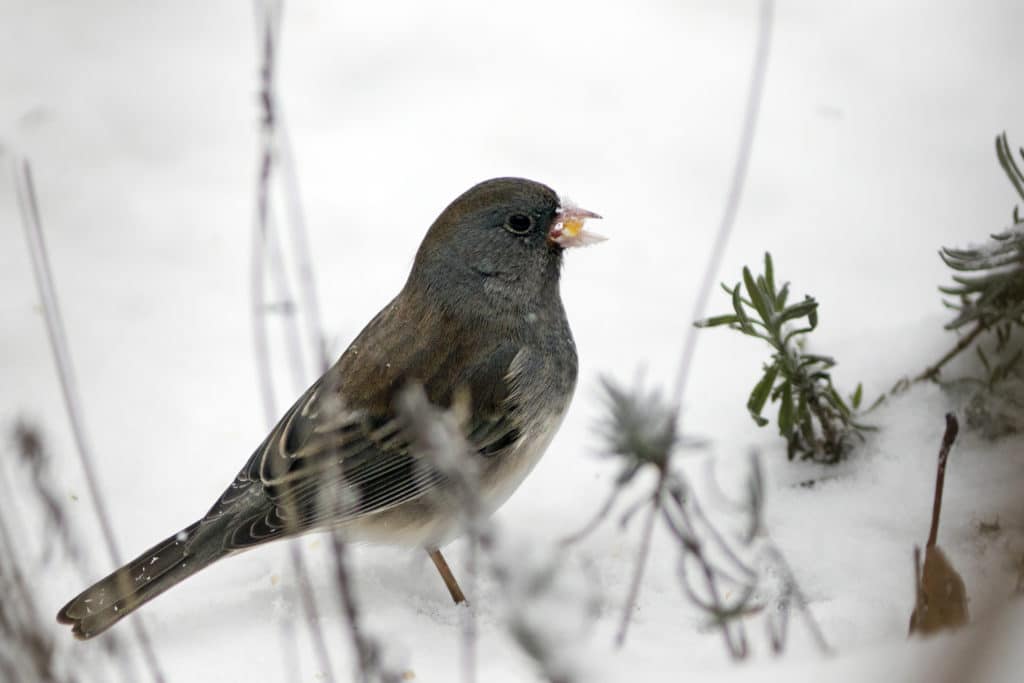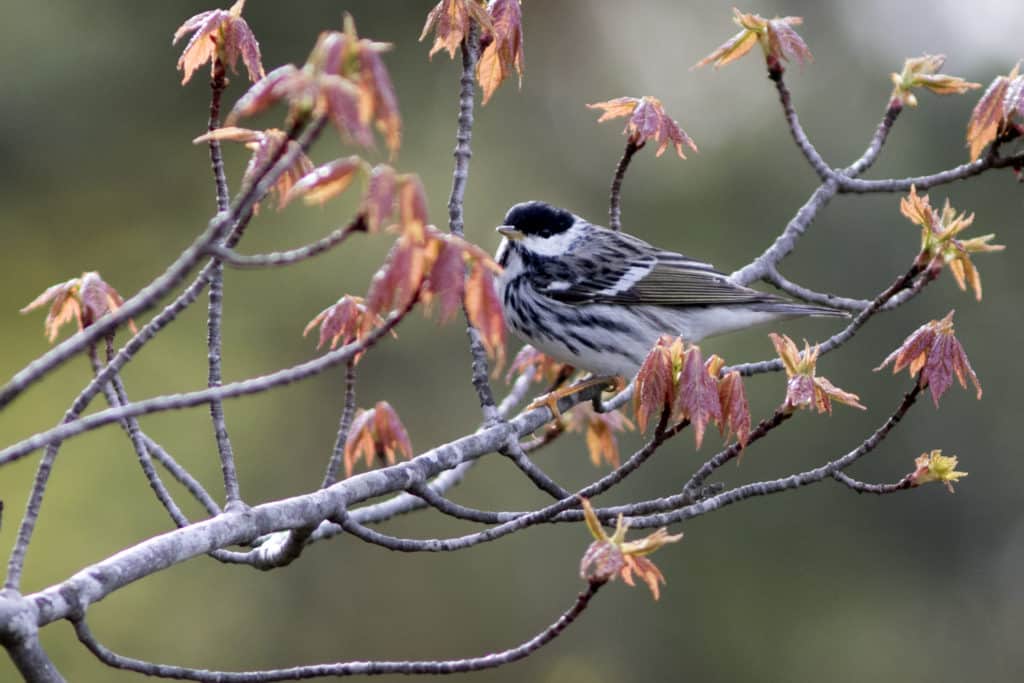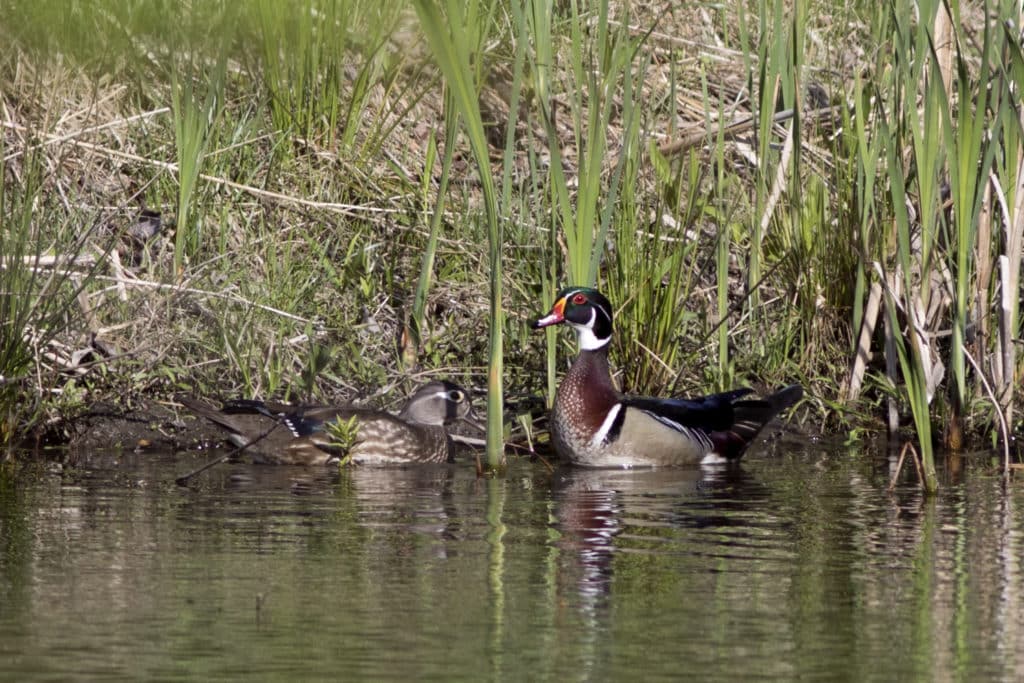
(A shorter version of this article appears in the Winter 2021/22 issue of Habitat Magazine)
My mom is a snowbird. Every year she heads south to Arizona for a few months in the winter to escape the snowy, icy northern clime. She enjoys the long warm sunny days, the plentiful fresh local fruits and vegetables, and the ease with which she can walk, swim, and garden. If you live in Maine, you probably know some snowbirds too.
But did you know snowbird was originally a nickname for the Dark-eyed Junco (pictured above), and in the 1920s was used to describe seasonal workers who moved from the north to the south for the winter months, or that Dictionary.com defines snowbird as “any of various birds that winter in a cold, snowy climate, especially the dark-eyed junco and the snow bunting”?
Just like human snowbirds, many of “our” birds head south for the winter. They breed here in Maine or pass through Maine on their way to breed even farther north, then head to warmer climes for many of the same reasons—it takes less energy to stay warm, the days are longer, and there is ample food of all kinds. Even some bats and insects migrate south for the winter, such as the Eastern Red Bat, Monarch Butterfly, and darner dragonflies (yes, dragonflies!—who knew?). Then there are the true snowbirds that visit us each winter, coming south from the Canadian taiga and tundra.
Let’s take a closer look at a few of these critters, from a variety of habitats here in Maine, and follow them on their amazing journeys. Where do they go? What do they do when they’re gone? Come with me on an armchair travelogue from the warm confines of your winter home. Let’s start at the northern tip of Maine and work our way south.
FORESTS
Last summer I hiked to the top of Saddleback Mountain and then on to The Horn with a few other hardy souls from the Rangeley Birding Festival in pursuit of one of rarest boreal birds—the Bicknell’s Thrush. We summited both peaks without sight or sound of the elusive bird and turned, dejected, to head back down. However, at the base of The Horn, I stopped for a short break and suddenly heard what I thought might be the thrush singing from a thicket of very stunted spruce trees. When I turned toward the song, I saw the bird sitting in plain sight atop one of the trees, singing away. People come from all across the country to see this bird, so I felt lucky to have such a great sighting.
Bicknell’s Thrush breeds in the subalpine forests of Maine’s mountains and farther north in Canada’s taiga forests. They like densely packed spruce and fir trees twisted by wind and rime and often covered in clouds. They feed primarily on insects, ants, and beetles and nest about five feet off the ground in dense thickets. Their numbers are small, and they are listed as a Species of Greatest Conservation Need (SGCN) in Maine’s Wildlife Action Plan. During migration, they seek similar types of dense forest habitat; they overwinter in wet montane forests in the Greater Antilles islands of Cuba, Hispaniola, Jamaica, and Puerto Rico. Unlike me, I guess they like claustrophobic settings and damp weather!
Blackpoll Warblers breed in wet black spruce and tamarack forests that stretch from northern Maine, across Canada, and up to Alaska. I first met Blackpoll Warblers when I was conducting breeding bird surveys in peatlands of Maine. They like the black spruce forests with wet feet that formed a ring around bogs, and I loved listening to their wispy song and trying to find them grazing on insects on the spindly branches of the trees. Their coloring matches the trunks of the stunted spruce so they are very hard to find. Most Blackpolls migrate south to the coast of Maine or Maritimes before jumping off and flying nonstop over 1800 miles to overwinter in either the Caribbean or northern South America, east of the Andes. The trip takes them about 88 hours, so they need to double their weight before heading south. Imagine all the energy needed to make that flight!
In the spring, they fly slowly up through Central America or the Caribbean and across the Gulf of Mexico before heading north along either the Atlantic or Midwest Flyways. In the winter, they can be found in forest edges and second-growth forests below 10,000 feet, and during migration they stop in mature evergreen and deciduous forests. Habitat loss is shrinking their wintering grounds; and logging and other extractive industries, plus climate change, threaten their boreal breeding grounds. That’s why Maine Audubon is working with forest landowners, foresters, and loggers all across Maine to improve breeding habitat for Blackpolls and many other forest birds of conservation concern through our Forestry for Maine Birds program.

Five of Maine’s bats hibernate in large groups in caves. However, tree bats—or those that roost hanging underneath leaves and nest singly or in small groups in tree cavities or under the bark of trees—do not hibernate in caves for the winter, but migrate to southern parts of the U.S. and then hibernate, hiding in hollow trees or under leaf litter. There are three tree bats in Maine—the Hoary Bat, Silver-haired Bat, and Eastern Red Bat. Eastern Red Bats mate during the fall migration, and females give birth the following spring. Little is known of their actual migratory pathway or final wintering range.
STREAMS AND WETLANDS
Forests cover over 95% of the state, but tucked among those forests are many streams, wetlands, ponds, and lakes, so let’s take a quick look at some of the migratory species that breed in those habitats as well.
What could be more thrilling than to see a Wood Duck swimming and flying along the course of a river? These birds favor streams, swamps, marshes, beaver ponds, and floodplain forests, with ample vegetation along the shore for finding food and hiding from predators, and adjacent to upland forests for nesting. Contrary to popular notions, they do not nest only in Wood Duck boxes, but in natural cavities in larger, older trees—sometimes over a mile away from water. Wood Ducks in Maine and Canada migrate to the southern U.S. or Mexico for the winter, but in other parts of the U.S. where the water doesn’t freeze, they can be found year-round.

Moving from freshwater to saltwater, one of the hidden gems that makes its home in saltmarshes along Maine’s coast is the Saltmarsh Sparrow—a cryptic bird that nests in the high marsh grass and is accustomed to being occasionally flooded by high tides. When that happens, the young climb up on the tall grasses around their nest and take refuge until the tide subsides. Lately, with sea level rise, that trick doesn’t always work, so Maine Audubon is working with biologists from Rachel Carson National Wildlife Refuge who are experimenting with building floating nest platforms somewhat similar to those sometimes used for nesting loons. While in Maine, they feed on insects and cordgrass seeds found in saltmarshes. Saltmarsh Sparrows migrate south along the Atlantic coast, stopping in saltmarshes along the way, with some wintering in Florida or the Gulf Coast.
By now, most everyone has heard about the amazing migratory journeys of the Monarch Butterfly, but did you know that some dragonflies also have a multi-generational, migratory lifestyle? A recent study documented the Common Green Darner migration, which involves at least three generations – that travel 400 miles from their southern to northern ranges and back – each year. The young spend most of their time in the water as dragonfly nymphs, and only a short time flying around as adults, when we are most likely to see them. Community scientists trained by Maine Audubon and partners are searching for nymphs through our Stream Explorers program to help document stream water quality.
LAKES
When most Mainers think of loons, they think of haunting wails and scenes of young chicks riding on parents’ back on our freshwater lakes during the warmer breeding months. But did you know that these same loons normally winter in ocean waters off the Atlantic coast and actually spend more of their life on the ocean than on freshwater lakes and ponds? In the frosty months, you’ll often find Common Loons socializing in groups and eating seafood meals including crabs, flounder, and herring. Because our lakes freeze, Common Loons normally migrate in late fall to salty waters including coastal bays and coves and sometimes even frequenting areas up to 60 miles offshore.
Many loons that summer in Maine will do just a short skip from their breeding lake to New England’s coastal waters. This short migration, which enables them to expend less energy than those traveling farther, is believed to be the primary reason that Maine’s loons weigh in higher than loons from other states. Some of Maine’s breeding loons do travel farther south, however, to wintering sites in New Jersey, Maryland and beyond. Wherever they travel, most will return to the same four to eight square miles of ocean every winter.
Common Loons are flightless for a few weeks in midwinter when they undergo a complete wing molt, at which time they are particularly vulnerable to threats such as oil spills. Because hundreds were harmed or killed from an oil spill off the coast of Massachusetts/Rhode Island in 2013, Maine Audubon and partners will be working over the next five years to help boost loon nesting success across the state.
GRASSLANDS AND BEACHES
Grasslands and beaches—though they are not extensive in Maine—are of particular interest to us. Most of our grassland birds have shown dramatic declines in recent decades and the only shorebird that nests on our beaches is endangered. Helping these species during breeding and migration is an important conservation goal for Maine Audubon and many other organizations.
Like other grassland birds—those that used to nest in the tallgrass and mixed grass prairies of the central and western U.S. and Canada—Bobolinks now nest in large fields, meadows, and hayfields across the northern U.S., including in Maine. They have a bubbly song that rises with them above the field grass, and they feed on seeds, insects, and spiders. After breeding, they move to marshes to molt before flying in groups across Florida and the Gulf of Mexico, making a long stopover in Venezuela, then settling in south of the equator in Bolivia, Paraguay, and Argentina for the winter—an annual round trip of over 12,000 miles!
Other Maine grassland birds include Eastern Meadowlark, which nests in pastures, fields, and other grassy areas, and migrates up to 600 miles to the southern U.S.; and the Savannah Sparrow, which nests in fields, meadows, peatlands, and sedge wetlands, and winters in the southern U.S., Mexico, and the northern tip of Central America.
Many shorebirds such as the Semipalmated Sandpiper migrate through Maine on their way to nesting areas in the Arctic and wintering areas in the Caribbean and Central and South America, but there’s only one that nests on the beaches of southern Maine: the Piping Plover. Piping Plovers make a scrape in the sand for a nest, typically lay four eggs, and usher their chicks around the beach searching for insects and other invertebrates in the seaweed rack and mudflats. In late summer, they depart. But to where?
We are still learning more every year about Piping Plover migration and wintering habitat. Many of them winter on remote sandy cays that are expansive and difficult to access. In 2012 about 10% of all the Atlantic Coast population of plovers was observed at Joulter Cays in the Bahamas—a new discovery. Now, through an intensive collaborative conservation effort, the area is on its way to becoming a National Park partially due to these recent discoveries. Nesting Maine plovers have also been found wintering in South Carolina and Georgia.
SNOWBIRDS
The “true snowbirds”—birds that move south into Maine from northern Canada to spend their winter with us—are some of my favorite birds as they love northern winters as much as I do.
Juncos, snow buntings, redpolls, snowy owls, and more visit us each winter from the Canadian taiga and tundra. Every few years I see Snow Buntings forage in the snowy hayfields near my home in southern Maine, and I always stop to marvel at their small size but tough nature. They remind me of the many wonders and challenges of traveling in the high Canadian Arctic where they breed, making a nest in rock crevices lined with moss, grass, fur, and feathers to keep the young warm. They feed on grass and flower seeds, insects, and spiders.
Other snowbirds include Lapland Longspurs, Dark-eyed Juncos, Common Redpolls, and Bohemian Waxwings. Often these birds travel in flocks, searching for food and avoiding predators by sticking together. These are the birds you should be looking for this winter at your feeder or when you are out walking, skiing, or snowshoeing. They will keep you company, bundled up against the cold, ready to embrace all of winter’s glory.
